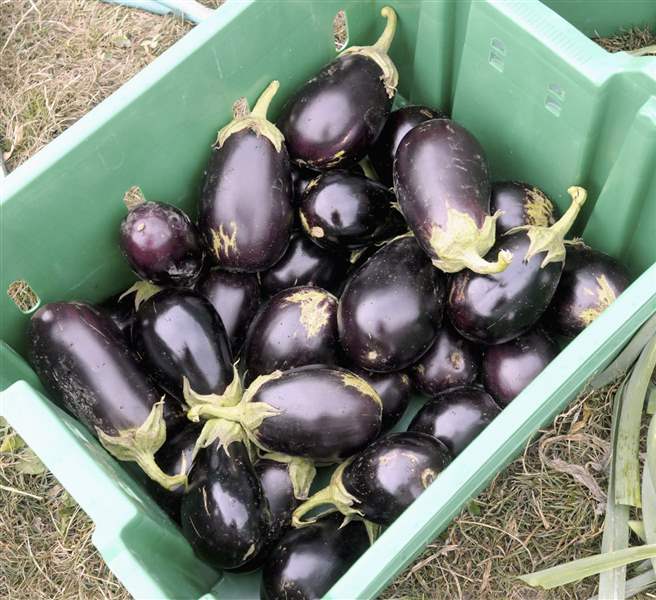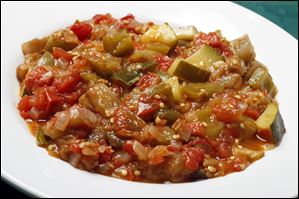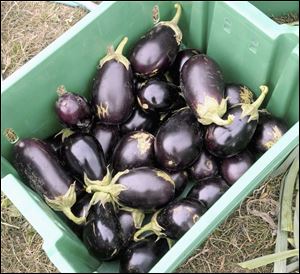
Eggplants are a real charmer in the kitchen
8/21/2012
Freshly picked eggplants sit in a container at the University of Illinois Sustainable Student Farm in Urbana, Ill.
Associated Press

Eggplant ratatouille.
Scientifically speaking, plants don't have eggs.
So why is an eggplant called an eggplant? It doesn't really look like an egg, except in the very broadest of terms. And even then, it looks like an enormous purple egg with a little green beanie on top.
Like tomatoes, eggplants are actually fruit (without going into the details, they are technically berries). And also like tomatoes, they are members of the nightshade family -- many of which are poisonous.
Eggplants are not. Which is a good thing because they are so delicious. Except that they aren't.
By themselves, eggplants have relatively little flavor, and are somewhat bitter. Eating it raw is not actually unpleasant, but it improves immeasurably when it is cooked. And it is best of all when cooked with a number of other foods, because eggplant's great charm is that it complements and absorbs other flavors like a sponge.
A better name for it might be "spongeplant," which at least makes more sense than eggplant.
Though a native of India, eggplants are now most closely associated in America with Mediterranean cuisine, so they are often found in a pot alongside garlic, onions, tomatoes, lemon, pine nuts, and the like. A longer and skinnier cousin -- it looks like a purple giant's finger -- is grown in Asia and is most often paired with Asian flavors such as ginger, sesame, chiles, soy sauce, and cilantro.

Freshly picked eggplants sit in a container at the University of Illinois Sustainable Student Farm in Urbana, Ill.
Because eggplant contains so much water in its flesh, it is often advisable to concentrate its flavor by drawing out some of that liquid. All you have to do is cut the eggplant into pieces, salt them liberally, and put them in a colander in the sink or over a plate to catch the liquid. Let the eggplant sit for a half-hour or an hour; you can use that time to prepare the rest of the ingredients. When you are ready to use the pieces, rinse the salt off of them and then pat them dry on paper towels.
The easiest way to cook eggplant is simplicity itself; it doesn't even require the pre-salting phase. Cut an unpeeled eggplant into slices a half-inch thick, drizzle a little olive oil over the slices (but remember, eggplant is spongelike with oil, too), top them with salt and pepper and roast them in a 400° oven for 30 minutes or so. Just as easy, and even better, is to prepare the slices the same way and grill them over a fire or even on a grill pan. No one will think less of you if you want to add a little minced garlic before you start to cook them, or if you first marinate them briefly in a simple vinaigrette.
When most people think of eggplant, they probably think of three dishes: ratatouille, moussaka, and eggplant parmesan. Eggplant parmesan, when done right, can take the better part of an afternoon, so we decided to save it for another day.
Ratatouille was first associated with the golden, green, and lavender fields of Provence, where the local residents chopped up all of their most commonly available produce, threw it all in a pot, and cooked it until it achieved a kind of culinary nirvana. Each ingredient maintains its individual taste, but each one also helps to flavor all of the others.
The genius of ratatouille is that you can make it as the old Provençal cooks did, by mixing together anything you have on hand. All that are absolutely necessary are eggplant, zucchini, tomatoes, bell peppers, onions, and garlic. Fresh herbs are also welcome if you have them.
Moussaka, of course, is one of the most famous and popular dishes from Greece. Time-consuming but absolutely worth the effort, it features the unbeatable combination of eggplant, tomato, and ground lamb. Ground beef, which is much more easily found, works almost as well. Cooked as a layered casserole until the eggplant is so tender it can be cut with a fork, moussaka is perhaps most notable for its top layer of bechamel sauce.
A French sauce by origin, bechamel is a clever way to add as many calories to any given dish as possible, and then to make it taste so good you don't care. Basically, you make a roux of melted butter and flour, stir in hot milk until smooth, and then add egg yolks (or a mixture of egg yolks and cream, if you want to be especially naughty). It is sheer, edible bliss, but if you're watching your weight it really isn't something you should eat too often.
In Israel, a popular way to serve eggplant is to roast it over a flame -- you can do it over a gas stove, which is as convenient as it is messy -- split it in half, and then serve it topped with separate piles of several condiments at once, such as yogurt, honey, tomatoes, olive oil, lemon juice, and garlic. It is an irresistible way to mix and match several taste sensations in one.
One of my favorite dishes at one of my favorite Italian restaurants is a sauce for pasta made from eggplant, tomatoes, and onions, plus a few pine nuts for a satisfying nuttiness and a handful of plump raisins for a splash of near-decadent sweetness. Knowing the basic ingredients, I decided to try to make it myself. It is primarily a tomato sauce, so after layering the flavors by sauteing onions and garlic, I added a good amount of chopped fresh tomatoes. These I first simmered with the lid on, in order to help break down the tomato chunks. Then I added the eggplant and simmered it uncovered to allow the sauce to reduce.
While the sauce was cooking, I toasted a handful of pine nuts and poured boiling water over a half-cup of raisins to plump them. Then I looked at those two ingredients, sized up the pan of sauce I had made, and realized I had prepared about twice as many pine nuts and raisins as I needed. They should be used sparingly, almost as condiments, rather than as major components of the sauce. I wound up using about half a handful of pine nuts -- just one tablespoon -- and one-quarter cup of raisins.
The sauce can be served with any pasta you like. I used spaghetti to keep it simple, but it also goes well with penne, especially when a little of the sauce gets into the tubes.
Finally, I made an eggplant pilaf, a Turkish recipe that makes use of fragrant spices -- cumin seeds and coriander seeds -- as well as tomato paste for a rich, surprisingly robust taste. As is the case with all of these dishes, except the baked or grilled eggplant slices, the pilaf benefits from a night in the refrigerator to allow the flavors to blend.
So I intended to let it sit for a night. But I had to have a taste, right? So I had a taste. And another. And another. And another.
I didn't eat the entire dish that night, but for a while there it was touch and go.
Contact Daniel Neman at dneman@theblade.com or 419-724-6155.